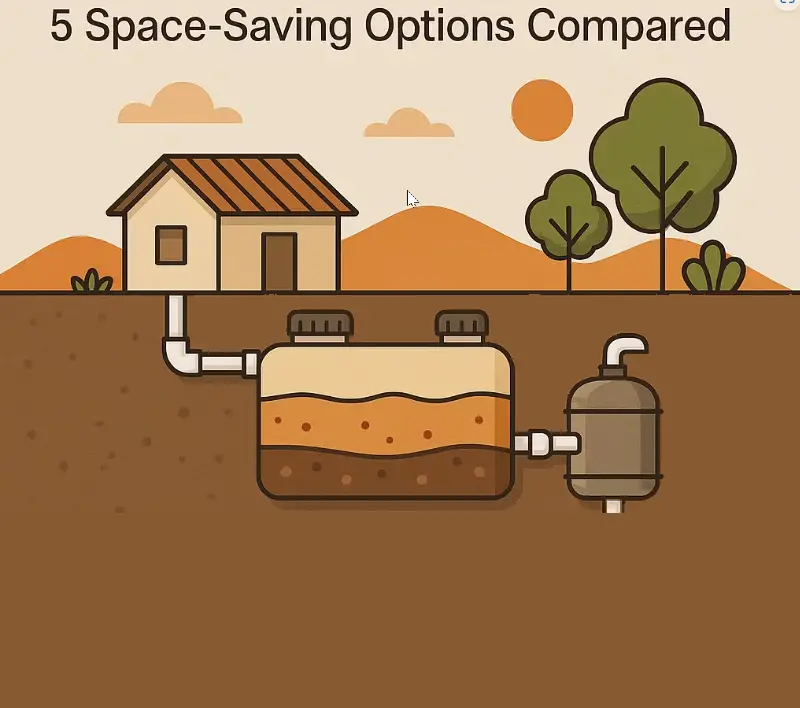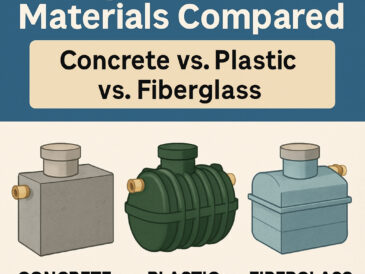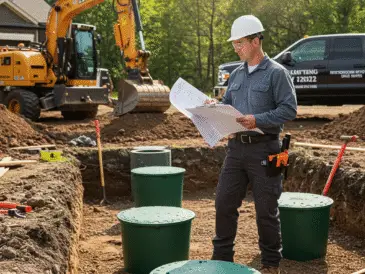Your trusty septic tank has been faithfully processing your household waste for years, but lately, you’ve been hearing whispers about something called an “aerobic treatment unit” that could revolutionize your septic game. Well, buckle up buttercup, because we’re diving deep into the world of ATUs – those fancy oxygen-loving systems that are making traditional septic tanks look like rotary phones in a smartphone world.
Choosing the right aerobic treatment unit isn’t just about picking the shiniest model or the one with the coolest name (though “Singulair” does sound pretty impressive at dinner parties). It’s about finding a system that’ll handle your household’s waste like a champ while keeping your wallet from staging a revolt. Whether you’re dealing with challenging soil conditions, tight lot constraints, or simply want to upgrade to the Tesla of septic systems, this comprehensive review will help you navigate the ATU landscape like a pro.
What is an Aerobic Treatment Unit?
Think of an aerobic treatment unit as your septic system’s overachieving cousin who went to college and came back with a degree in environmental engineering. While traditional septic systems rely on anaerobic bacteria (the ones that work without oxygen) to break down waste, ATUs pump air into the mix, creating a party atmosphere for aerobic bacteria that are absolute rockstars at cleaning wastewater.
The magic happens in multiple stages: first, solids settle out just like in a regular septic tank. Then comes the star of the show – the aeration chamber, where millions of tiny bubbles create an oxygen-rich environment that supercharges bacterial activity. Finally, the treated water moves to a clarification chamber where any remaining particles settle out, leaving you with effluent so clean it could practically win a beauty contest.
The advantages over traditional septic systems are nothing to sneeze at. ATUs produce effluent that’s typically 90% cleaner than conventional systems, making them perfect for environmentally sensitive areas, shallow soil conditions, or properties near water bodies. They also have a smaller footprint, making them ideal for tight lots where a traditional drain field would require you to sacrifice your prized rose garden.
Factors to Consider When Choosing an ATU
Before you fall head-over-heels for the first ATU that catches your eye, let’s talk about the practical stuff that’ll determine whether your new system becomes your best friend or your biggest headache.
Household Size and Daily Wastewater Volume
Your ATU needs to handle whatever your household dishes out – literally. A family of two empty-nesters won’t stress a system the same way a household with three teenagers who think 45-minute showers are a basic human right. Most residential ATUs handle 500 to 1,500 gallons per day, so do the math and add a buffer for those days when everyone decides to do laundry simultaneously.
Local Installation and Permitting Regulations
Here’s where things get spicy – local regulations can be pickier than a food critic at a gas station buffet. Some areas require specific certifications, setback distances, or even particular brands. Check with your local health department before you get your heart set on any particular unit, because nothing kills the ATU romance like finding out your dream system isn’t approved in your county.
Maintenance Requirements and Service Availability
ATUs aren’t the “set it and forget it” rotisserie chickens of the septic world. They need regular love and attention, including periodic inspections, air filter changes, and occasional pump maintenance. Make sure you’ve got qualified service technicians in your area, or you might find yourself playing very expensive guessing games when something goes wrong.
“The biggest mistake I see homeowners make is choosing an ATU based solely on upfront cost. A cheaper unit that requires constant service calls will cost you more in the long run than investing in a quality system with reliable local support.”
– Mike Rodriguez, Certified Septic System Inspector
Energy Consumption and Operational Costs
Those air pumps don’t run on good intentions – they need electricity, and that means ongoing operational costs. Most residential ATUs use about as much power as a refrigerator, but energy-efficient models can help keep your electric bill from staging a mutiny. Factor in electricity costs, maintenance contracts, and periodic part replacements when calculating your total cost of ownership.
Top 7 Best Aerobic Treatment Units for Septic Systems
1. Norweco Singulair
The Norweco Singulair is like the reliable pickup truck of ATUs – it’s been around forever, everyone knows someone who has one, and it just keeps chugging along. This single-chamber system uses a bio-kinetic process that’s simpler than a two-step dance but effective enough to make environmental engineers weep tears of joy.
Key Features: Single-chamber design, minimal moving parts, NSF Standard 40 certified, and a track record longer than your grocery receipt.
Pros: Proven reliability, widely available service support, relatively simple maintenance, and excellent treatment performance.
Cons: Higher upfront cost, requires regular electrical maintenance, and the alarm system can be more sensitive than a smoke detector near your kitchen.
Best for: Homeowners who want a proven system with excellent long-term reliability and don’t mind paying a premium for peace of mind.
2. Hydro-Action AN Series
The Hydro-Action AN Series brings some serious engineering muscle to the party. This system uses a unique combination of fixed film and suspended growth processes that sounds fancy enough to impress your engineer neighbor but works simply enough that you won’t need a PhD to understand it.
Key Features: Dual-treatment process, energy-efficient design, compact footprint, and NSF/ANSI Standard 40 certification.
Pros: Excellent treatment quality, lower energy consumption than many competitors, and handles hydraulic shock loads like a champ.
Cons: Limited service network in some areas, higher complexity than single-chamber systems, and replacement parts can be pricier than craft beer.
Best for: Properties with variable water usage patterns or environmentally sensitive locations where superior effluent quality is non-negotiable.
3. Jet BAT Media Plant
The Jet BAT system is the overachiever of the group, using fixed film media that provides more surface area for beneficial bacteria than a luxury apartment complex. It’s particularly popular in areas where soil conditions are more challenging than a Sunday crossword puzzle.
Key Features: Fixed film media technology, compact design, excellent BOD and TSS removal, and robust construction that could probably survive a small earthquake.
Pros: Superior treatment performance, handles varying loads well, minimal sludge production, and low maintenance requirements.
Cons: Higher initial investment, specialized service requirements, and the media may need replacement every 10-15 years.
Best for: Challenging sites with poor soil conditions or strict discharge requirements where treatment quality trumps everything else.
4. Enviro-Flo ATU
The Enviro-Flo system takes a no-nonsense approach to wastewater treatment. It’s like the sensible sedan of ATUs – not flashy, but it gets the job done efficiently and won’t leave you stranded on the side of the road.
Key Features: Extended aeration process, simple operation, NSF certification, and a design that prioritizes reliability over bells and whistles.
Pros: Cost-effective operation, straightforward maintenance, good treatment performance, and wide availability of service support.
Cons: Larger footprint than some competitors, higher energy consumption, and the basic design might not win any beauty contests.
Best for: Budget-conscious homeowners who want solid performance without fancy features or those in areas with readily available service support.
5. AquaKlear AK Series
The AquaKlear AK Series brings some innovative thinking to ATU design with its sequencing batch reactor technology. It’s like having a smart system that knows when to work hard and when to chill out, optimizing treatment cycles based on actual usage.
Key Features: Sequencing batch reactor design, automated operation cycles, excellent nutrient removal, and smart controls that would make your smartphone jealous.
Pros: Superior nitrogen removal, energy-efficient operation, handles variable flows expertly, and produces consistently high-quality effluent.
Cons: Complex control systems, higher upfront costs, specialized service requirements, and more potential failure points than simpler systems.
Best for: Properties near sensitive water bodies where nitrogen removal is critical or homes with highly variable water usage patterns.
“Modern ATUs like the AquaKlear series are game-changers for coastal properties. The nitrogen removal capabilities can mean the difference between getting a permit and having to look for a new house.”
– Sarah Chen, Environmental Engineer and Septic System Designer
6. Clearstream Wastewater Systems
Clearstream systems bring a modular approach to ATU design that’s more flexible than a yoga instructor. Their systems can be configured for various capacities and treatment levels, making them adaptable to different site conditions and regulatory requirements.
Key Features: Modular design, scalable capacity, advanced treatment technology, and NSF Standard 40 compliance that checks all the regulatory boxes.
Pros: Highly customizable, excellent treatment performance, good manufacturer support, and the ability to expand capacity if needed.
Cons: Higher complexity, premium pricing, limited service network in some regions, and installation requires experienced contractors.
Best for: Custom applications, large homes, or properties with specific site constraints that require a tailored solution.
7. Delta Whitewater ATU
The Delta Whitewater system rounds out our list with a focus on simplicity and reliability. It’s designed for homeowners who want effective treatment without the complexity of high-tech systems that require a computer science degree to operate.
Key Features: Simple extended aeration design, robust construction, minimal maintenance requirements, and a price point that won’t require a second mortgage.
Pros: Affordable operation, straightforward maintenance, reliable performance, and good availability of replacement parts.
Cons: Basic treatment levels, larger space requirements, higher energy usage, and limited advanced features.
Best for: Rural properties with ample space, homeowners prioritizing simplicity and cost-effectiveness, or areas with basic treatment requirements.
Installation and Maintenance Tips
Installing an ATU isn’t a weekend DIY project unless your weekends typically involve excavators and electrical permits. Working with a certified septic system installer isn’t just recommended – it’s usually required and definitely worth every penny. These professionals know the local codes, understand soil conditions, and can spot potential problems before they become expensive disasters.
Understanding manufacturer requirements is crucial for maintaining your warranty and ensuring optimal performance. Each system has specific installation guidelines, from electrical connections to plumbing configurations. Skipping steps or taking shortcuts might save time initially, but it’ll cost you dearly when warranty claims get denied or performance suffers.
Routine maintenance is where many homeowners drop the ball harder than a buttered football. Your ATU needs regular attention including air filter cleaning or replacement, checking electrical connections, monitoring alarm systems, and periodic inspections by qualified technicians. Think of it as preventive healthcare for your septic system – a little attention now prevents major surgery later.
“The homeowners who get the best performance and longevity from their ATUs are the ones who treat maintenance like they treat their car service schedule – non-negotiable and on time, every time.”
– Tom Wilson, Licensed Septic System Contractor with 25 years experience
Conclusion
Choosing the best aerobic treatment unit for your septic system doesn’t have to be more complicated than solving a Rubik’s cube blindfolded. The Norweco Singulair stands out for proven reliability, while the Hydro-Action AN Series excels in energy efficiency. For challenging sites, the Jet BAT Media Plant delivers superior treatment, and the AquaKlear AK Series shines where nitrogen removal is critical.
The key is matching your specific needs – household size, site conditions, local regulations, and budget – with the right system characteristics. Don’t get seduced by fancy features you don’t need, but don’t shortchange yourself on critical performance aspects either.
Remember, an ATU is a long-term investment in your property and the environment. While the upfront costs might make your wallet wince, the improved treatment performance, smaller footprint, and potential property value increase make it worthwhile for many homeowners. Just make sure you’re prepared for the ongoing maintenance responsibilities and operational costs.
Before making your final decision, consult with local septic professionals who understand your area’s specific requirements and soil conditions. They can provide invaluable guidance on system selection, installation requirements, and ongoing support that’ll keep your ATU running smoothly for years to come.
Frequently Asked Questions
How do aerobic treatment units differ from anaerobic systems?
The main difference is oxygen – aerobic systems actively pump air into the treatment process, while anaerobic systems (traditional septic tanks) work without oxygen. This makes aerobic systems much more efficient at breaking down waste and produces cleaner effluent. Think of it as the difference between a power tool and a hand tool – both get the job done, but one works faster and more effectively.
Can I install an ATU myself?
While you might be handy enough to build a deck or install kitchen cabinets, ATU installation typically requires licensed professionals. Most jurisdictions require certified installers, electrical work needs proper permits, and warranty coverage usually depends on professional installation. Plus, a botched installation can cost thousands more to fix than hiring professionals from the start.
What is the lifespan of a typical ATU?
A well-maintained ATU typically lasts 15-25 years, similar to traditional septic systems. However, certain components like air pumps may need replacement every 3-7 years, and electrical parts might require attention more frequently. The key to longevity is consistent maintenance and prompt attention to any issues that arise.
Are ATUs more environmentally friendly?
Generally yes – ATUs produce much cleaner effluent than conventional septic systems, with significantly lower levels of nitrogen, phosphorus, and other pollutants. This makes them better for protecting groundwater and surface water quality. However, they do use electricity, so there’s a small carbon footprint to consider.
How often do ATUs need maintenance?
Most ATUs need professional inspection and maintenance every 6-12 months, with some components requiring attention more frequently. Air filters might need monthly cleaning, electrical connections should be checked regularly, and alarm systems need periodic testing. It’s more hands-on than a traditional septic system, but the improved performance is usually worth the extra attention.




